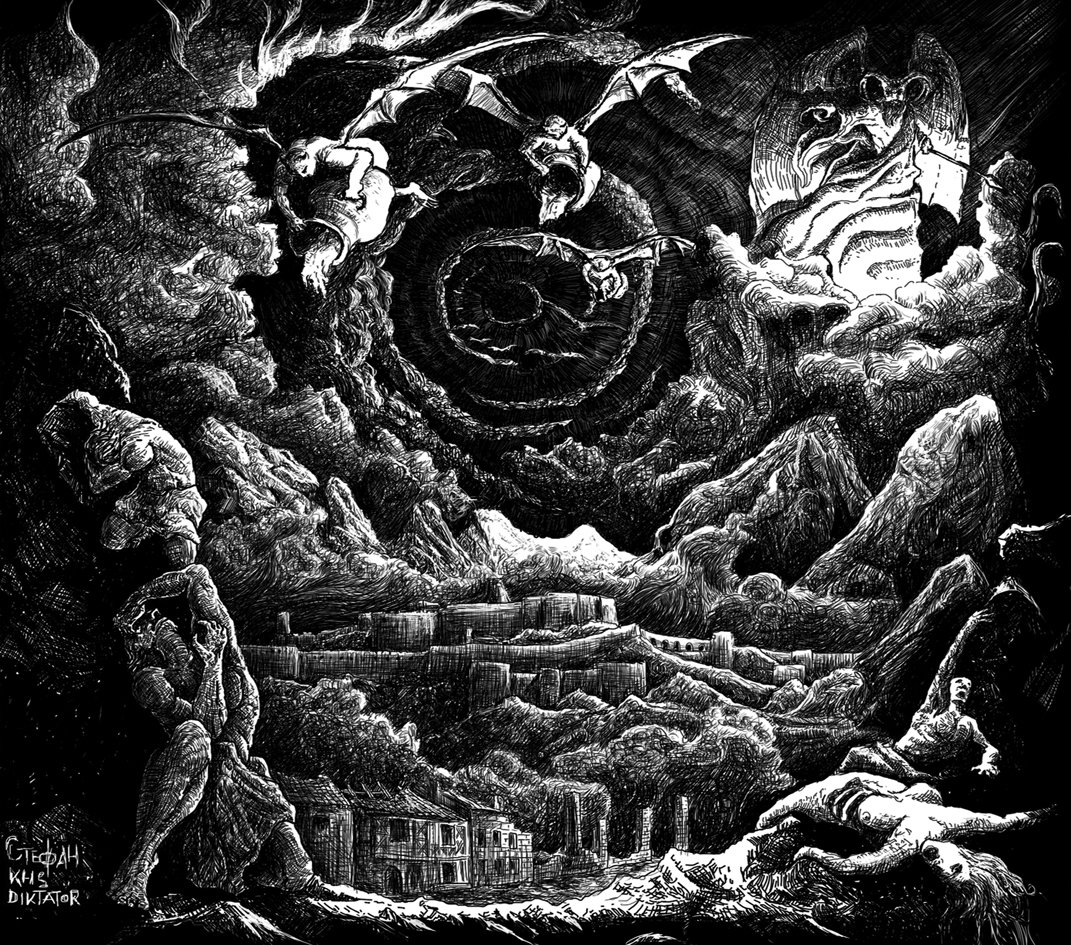...we lost a legend.
Lemmy Kilmister died. He was 70. His death came just days after his 70th birthday; a few months after Motörhead released their 22nd album Bad Magic; and a few years since the eponymous documentary about him cemented Motörhead's place in pop culture as the metal band non-metalheads love (and never actually listen to, I'm guessing).Not that I listen to Motörhead that regularly myself. Honestly speaking, the last album I heard all the way through was Kiss of Death from nearly a decade ago (and the last Motörhead album I loved all the way through was Hammered from a few years before that).
That aside, it's impossible to overestimate Lemmy's importance to heavy metal (even as the man himself was quick to diminish metal's importance to him). Certainly, every louder/faster/rawer sub-genre of metal owes its existence to Motörhead. Thrash wouldn't exist without them; their influence is all over the first Venom and Bathory albums, and Hetfield cribbed both Lemmy's delivery and his mutton chops. Even on the other side of the aisle, there's no shortage of punk and hardcore bands who will disparage metal and praise Motörhead in the same sentence.
Just as it's impossible to overestimate the man's importance, it's equally impossible to quantify what his loss means to the metal world. Certainly, in the last few decades the genre has gotten increasingly more niche, and too much attention - positive and negative - are lavished on bands that quickly appear on the scene and just as quickly disappear. True OGs are hard to find, and we've been losing them with frightening regularity in recent years. RIP, Lemmy: You were a reliable truth in a world of falsehood.
...Slayer released their first album without Jeff Hanneman.
When Jeff Hanneman died back in 2013, it sent shockwaves through the metal world. The future of Slayer seemed uncertain; his band (well, Kerry King) was resolute that they would continue, despite the fact that Hanneman was arguably responsible for the band's most iconic material.Repentless isn't a bad album. In style and quality, it's probably the most consistent album that Slayer have made since their last truly great one, 1990's Seasons In The Abyss. Though it lacks the highs of Slayer's Eighties heyday, there's none of the awkward groove metal moments that made Diabolus In Musica and God Hates Us All such uncomfortable listens. Frankly speaking, it's better than any late period album from an aging metal band has any right to be. With the band (well, Tom Araya) hinting for years that they're nearing the end, anyone who's ever taken a deep breath and yelled "SLAAAAAAAYEEEEEEERRRRRGH!" should skip the nit-picking and just enjoy them for as long as that's still possible.
HIGHLIGHTS: Repentless, Implode, Piano Wire
...20 years had passed since I joined the Campaign for Musical Destruction
2015 marked 20 years since I first started listening to Napalm Death. I still remember seeing passing one of the "bad" kids in my high school wearing a shirt that proclaimed the band was on a "Campaign for Musical Destruction" (thanks/apologies to Lärm). Not long after I bought the Fear Emptiness Despair album. My life was never the same; neither was my relationship with my neighbours.
As fate would have it, Napalm released a new album this very year, the chimaeric Apex Predator - Easy Meat. The Swans and Voivod influences that have always been lurking in the band's DNA are now at the forefront, giving the album a disorientating, unsettling feeling. The album's MVP is Mitch Harris, who delivers a performance that underscores his standing as one of extreme metal's most inventive, unique, and under-rated guitarists.
Despite its more experimental bend, the album isn't wanting for all-out grind moments. With its target in mind - multinational corporations, natch - the band skewers corporate greed lyrically as much as they push themselves creativity. The band that invented grindcore three decades ago still aims to break new ground; if only their peers were so daring.
20 years since I joined the campaign; here's to the next 20.
HIGHLIGHTS: Smash A Single Digit, Cesspits, Hierarchies, One-eyed
...I finally saw the Ghost everyone was talking about
Though their set at MDF 2011 was one of the highlights of the fest that year, Ghost's quick ascent up the metal ladder seemed buoyed more by the mystery surrounding the band's identities (and their nifty costumes) than the actual music. What little I heard of Infestissumam did little to impress me and I quickly wrote the band off as a flash in the pan. So I'm as surprised as anyone by how much I enjoyed their latest album: Meliora is the best batch of songs the Nameless Ghouls have written, aided by an expansive production by pop producer Klas Åhlund. By moving on from slow spooky occult rock to incorporating a Queen-like grandeur, Ghost finally lived up to the hype; getting on Stephen Colbert's show was a nice touch as well.HIGHLIGHTS: From The Pinnacle to the Pit, Mummy Dust, He Is, Absolution
...Nadiwrath made me clutch grapefruits, hail Satan
What little I know of Greek black metal could fill a shot glass (and that shot would taste mostly of Rotting Christ and Septic Flesh). So Nadiwrath, a new-ish band with members of the slightly longer running Dodsferd came out of nowhere to satisfy my need for chilling melodies, misanthropic lyrics, and paeans to darkness and evil. In a year where the top tier of black metal was curiously silent, this quickly became my go-to for 2015.HIGHLIGHTS: Inner Commitment, No Pity For Your Kind, Breathless We Stand Upon Apocalypse
...Abyssal raised the bar for one-man death metal bands
It's hard to think of an album that affected me this year as profoundly as Antikatastaseis. Though Abyssal doesn't have the music school acumen of Gorguts, or the genre-shifting ambition (or cymbal array) of Ulcerate, there's an x-factor to this album that separates it from the rest of the recent wave of avant garde death metal bands. Every time I listen to this album I feel I'm witnessing the future of death metal take shape in front of me.HIGHLIGHTS: The Cornucopian, Veil Of Transcendence, Delere Auctorem Rerum Ut Universum Infinitum Noscas
...Krisiun kicked out the jams.
Anyone paying attention knows I love me some Krisiun. No other band represented death metal's return to prominence more than the Brazilian three-piece and their simple ethos of blastbeats and blasphemy. To the band's credit, they've varied their approach on recent albums - slightly more technical here, a little more epic there. On Forged In Fury, they've streamlined their sound to focus on single note-riffs over percussive rhythms - not dissimilar from what Sepultura did on Chaos A.D., but with enough pure speed for it to be recognizably Krisiun. Over the course of the last decade, this band has shown that they've got a lot more up their sleeves than they're ever given credit for.HIGHLIGHTS: Scars Of The Hatred, Ways of Barbarism, Timeless Starvation
...Hate Eternal made Morbid Angel irrelevant. [more so.]
Maybe that's too pithy an assessment; after all, Morbid Angel were well along the way to making themselves irrelevant with a string of unimpressive albums. But there's no denying that Hate Eternal have always been incredibly focused and reliable. Infernus, though still as dense and unrelenting as anything Erik Rutan has done with this band, is a strangely catchy affair that shows among the lessons that Rutan learned from his time with Trey and Dave, he learned not to over-think things and to give the audience what they want. I doubt very much that any future Morbid Angel album will top this.HIGHLIGHTS: Locust Swarm, Infernus, Zealot: Crusader Of War
...Old school death metal became interesting again when converted to VHS
I am unapologetic about writing off most things described as "old school" that were made after the first iPhone came out. But Canadian trio VHS found a new way to make classic death metal interesting for me: By cleverly tying it thematically to the old horror video culture of the 80's and 90's. This hits not just the death metal fan in me, but the lowbrow cinemiste who had a cardboard box full of dodgy horror video tapes. [Oh, Maniac Cop. I expected so little, and you still disappointed.] Their debut, Hi Fi Horror, encapsulates my yearly Halloween movie marathons: Barebones production value, chock full of schlock, and horny teens meeting grisly deaths at the hands of monsters (and sometimes killbots).HIGHLIGHTS: Fornicating in the Furniture Store, The Tastiest Chili in Texas, Hairspray and Bloodspray
...everything went black, and then prog.
2015 was a banner year for the avant, experimental side of black metal. (Relative) newcomers INI and Leprous joined fresh releases by second wave proponents Arcturus, Dødheimsgard, Enslaved and Sigh joined in showing how much black metal has wandered from its simplistic "no mosh no trend no fun" roots to epitomize the spirit of progressive rock. I'd even argue that black metal is the most progressive sub-genre in metal, a space where no vocal performance is too outlandish, no outside influence too distant to assimilate, and no display of guitar supremacy too ostentatious. Maybe it's a natural reaction to the reversion the genre experienced in the last few years, where bands were celebrated for simply copying older, better bands and any kind of deviation was frowned upon. We seem to be on the verge of a fresh burst of creativity in metal, with bands beginning to lose their fear of trying new things and being themselves; and the bands leading the charge are the ones who never had that fear.











